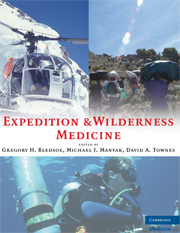Book contents
- Frontmatter
- Contents
- Contributors
- Foreword
- Preface
- Acknowledgments
- PART I EXPEDITION PLANNING
- PART II EXPEDITIONS IN UNIQUE ENVIRONMENTS
- PART III ILLNESS AND INJURIES ON EXPEDITIONS
- 24 General Medical
- 25 The Diarrhea of Travelers
- 26 Malaria: Diagnosis, Prevention, and Treatment for the Traveler
- 27 Wild Animal Attacks and Injuries
- 28 Snake and Arthropod Envenoming
- 29 Hazardous Marine Life
- 30 Expedition Toxicology
- 31 Environmental Injuries
- 32 Penetrating and Explosive Wounds
- 33 Drowning and Submersion Injury
- 34 Evaluation and Acute Resuscitation of the Trauma Patient
- 35 Principles and Practice of Expedition Wound Management
- 36 Expedition Eye Injuries and Disorders
- 37 Dental Medicine on Expedition
- 38 Foot Injuries
- 39 Expedition Orthopedics
- 40 Expedition Self-Rescue and Evacuation
- 41 Aeromedical Evacuations
- APPENDIX The Expedition Medical Kit
- Index
37 - Dental Medicine on Expedition
from PART III - ILLNESS AND INJURIES ON EXPEDITIONS
Published online by Cambridge University Press: 05 March 2013
- Frontmatter
- Contents
- Contributors
- Foreword
- Preface
- Acknowledgments
- PART I EXPEDITION PLANNING
- PART II EXPEDITIONS IN UNIQUE ENVIRONMENTS
- PART III ILLNESS AND INJURIES ON EXPEDITIONS
- 24 General Medical
- 25 The Diarrhea of Travelers
- 26 Malaria: Diagnosis, Prevention, and Treatment for the Traveler
- 27 Wild Animal Attacks and Injuries
- 28 Snake and Arthropod Envenoming
- 29 Hazardous Marine Life
- 30 Expedition Toxicology
- 31 Environmental Injuries
- 32 Penetrating and Explosive Wounds
- 33 Drowning and Submersion Injury
- 34 Evaluation and Acute Resuscitation of the Trauma Patient
- 35 Principles and Practice of Expedition Wound Management
- 36 Expedition Eye Injuries and Disorders
- 37 Dental Medicine on Expedition
- 38 Foot Injuries
- 39 Expedition Orthopedics
- 40 Expedition Self-Rescue and Evacuation
- 41 Aeromedical Evacuations
- APPENDIX The Expedition Medical Kit
- Index
Summary
INTRODUCTION
Common oral and dental emergencies encountered on field research expeditions and explorations in remote areas will be discussed in this section. Examples include fractured or broken teeth and jaws; tooth, jaw, and mouth trauma; loose, broken, or missing fillings; dislodged or fractured crowns or bridges; cracked or broken partial or full dentures; dislodged orthodontic brackets and wires; gum abscesses; tooth nerve inflammation; and other acute dental and oral swellings. The reader will learn how to recognize certain dental and oral conditions and treat them temporarily. A list of instruments and medications will be included as guides for the expedition dental emergency kit. Options for the kit are included and are based on risk in the field and treatment capability. Duration of the expedition, number of team members, and weight of supplies will also determine the size and weight of the dental kit.
PREPARATION
How do expedition team members prepare for the dental emergency? Roald Amundsen's notes from the Norwegian Antarctic Expedition of 1910–12 give some insight into the training that helped prepare that expedition for such an event.
Lieutenant Gjertsen, who had a pronounced aptitude both for drawing teeth and amputating legs, went through a “lightning course” at the hospital and the dental hospital. He clearly showed that much may be learnt in a short time by giving one's mind to it. With surprising rapidity and apparent confidence, Lieutenant Gjertsen disposed of the most complicated cases – whether invariably to the patient's advantage is another question, which I shall leave undecided.
- Type
- Chapter
- Information
- Expedition and Wilderness Medicine , pp. 595 - 610Publisher: Cambridge University PressPrint publication year: 2008



